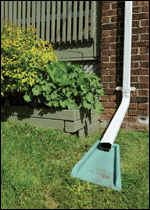This City of Toronto’s Mandatory Downspout Disconnection Video for property owners explains the risk of basement flooding and release of polluted rainwater into local waterways due to heavy rainfall overloading the sewer system via downspout connection:
Hence, for the benefit of everyone in Toronto, the City has made downspout disconnection mandatory, city-wide and enforceable via a bylaw – Chapter 681 (Sewers) of the Municipal Code (PDF).
The mandatory disconnection will come into effect in three phases in different areas of the city, over five years, starting late in 2011 with the following deadlines:
Phase 1 requires property owners of the following wards located in the central area of the city, where stormwater and sanitary drainage are combined into a single pipe, to disconnect their home’s downspout (s) from the sewer system by November 20, 2011:
Wards: 13, 14, 17, 18, 19, 20, 21, 22, 27, 28, 29, 30, 31, 32 and portions of 11, 12, 15, 16, 25, 26, 35, 36 and 37.
Phase 2 includes the basement flooding study areas. The disconnection deadline for these wards – Phase 2 – is December 3, 2013:
Wards: 33 and portions of 1, 3, 4, 5, 7, 8, 9, 10, 12, 15, 16, 23, 24, 25, 33, 34, 37, 39 40
Phase 3 requires property owners in the remaining wards of the city to disconnect by December 3, 2016:
Wards: 2, 6, 38, 41, 42, 43, 44 and portions of 1, 3, 4, 5, 7, 8, 9, 10, 11, 12, 15, 16, 23, 24, 25, 26, 34, 35, 36, 37, 39, 40
Please click here to find out which ward of Toronto you belong to as well as each ward’s profile.
Disconnecting your downspouts will help reduce the amount of stormwater sent through the sewer system.
Less stormwater can help prevent wastewater from backing up and thus reduce your risk of basement flooding.
Ways to keep rainwater on your property and manage what and how much goes into Toronto’s storm sewer system include:
- install a rain garden – in the following video, Bill Wilson gives us a tour of the permaculture rain garden in his front yard; please click here for more details and images
- plant a water-efficient, natural garden – please click here to consult the City’s water-efficient landscaping information
- removing impervious surfaces such as concrete pathways or patios to allow water to infiltrate
- consider using a rain barrel to capture and store rainwater
Bylaw exemption
Property owners who have considered all their options and find that disconnection is not technically feasible or could create a hazardous condition can apply to the City for an exemption by completing a Mandatory Downspout Disconnection Exemption Application.
Financial assistance
Financial assistance is available to reimburse the costs of labour and/or materials for performing downspout disconnection work, up to a maximum of $500, for low-income seniors or low-income persons with a disability who meet the criteria.
Please click here for frequently asked questions about mandatory downspout disconnection.
Contact Info for City of Toronto
Phone within Toronto city limits: 311
Phone outside city limits: 416-392-CITY (2489)
(can be used within Toronto if you can’t reach 311)
TTY customers: 416-338-0TTY (0889)
Fax: 416-338-0685
E-mail: 311@toronto.ca
If your matter is urgent, please call them. They are open 24/7.
Always call 911 for emergencies.

Toronto, Ontario, Canada
News Release
November 16, 2011
First downspout disconnection deadline on November 20
The deadline for property owners in Toronto’s central area to disconnect their downspouts from the sewer system is this Sunday, November 20. Downspout disconnection is an important step to reduce the risk of basement flooding and release of polluted rainwater into local waterways.
Downspout disconnection is mandatory across the City of Toronto but deadlines for compliance are being phased in between November 2011 and December 2016. This first deadline applies to houses in the central Phase 1 area of the city where stormwater and sanitary sewage are combined into a single pipe. Downspouts, before they are disconnected, carry rainwater directly into the sewer system, which can overflow causing flooded basements and polluted waterways. Disconnected downspouts, directed onto a lawn or garden, allow rainwater to percolate into the ground naturally.
During the summer, Phase 1 property owners received an information package notifying them of the need to comply with the bylaw. More information, including a map of the three phases, disconnection tips, Frequently Asked Questions, a video, and the Exemption Application, is available on the Toronto Water website at http://www.toronto.ca/water.
Disconnection in the Phase 2 area is required by December 3, 2013 and in the Phase 3 area by December 3, 2016.
Bylaw exemption
Property owners who have considered all their options and find that disconnection is not technically feasible or could create a hazardous condition can apply to the City for an exemption by completing a Mandatory Downspout Disconnection Exemption Application.
Financial assistance
Financial assistance is available to reimburse the costs of labour and/or materials for performing downspout disconnection work, up to a maximum of $500, for low-income seniors or low-income persons with a disability who meet the criteria.
Property owners can disconnect their downspouts on their own or hire a City-licensed and experienced eavestrough contractor to do the work. Overall, downspouts must be disconnected safely and properly.
Toronto is Canada’s largest city and sixth largest government, and home to a diverse population of about 2.7 million people. Toronto’s government is dedicated to delivering customer service excellence, creating a transparent and accountable government, reducing the size and cost of government and building a transportation city. For information on non-emergency City services and programs, Toronto residents, businesses and visitors can dial 311, 24 hours a day, 7 days a week.
——————————-
You may also want to know:
You’re Invited: RainScaping at Home! Workshops to Offset Impacts of Storm Water
